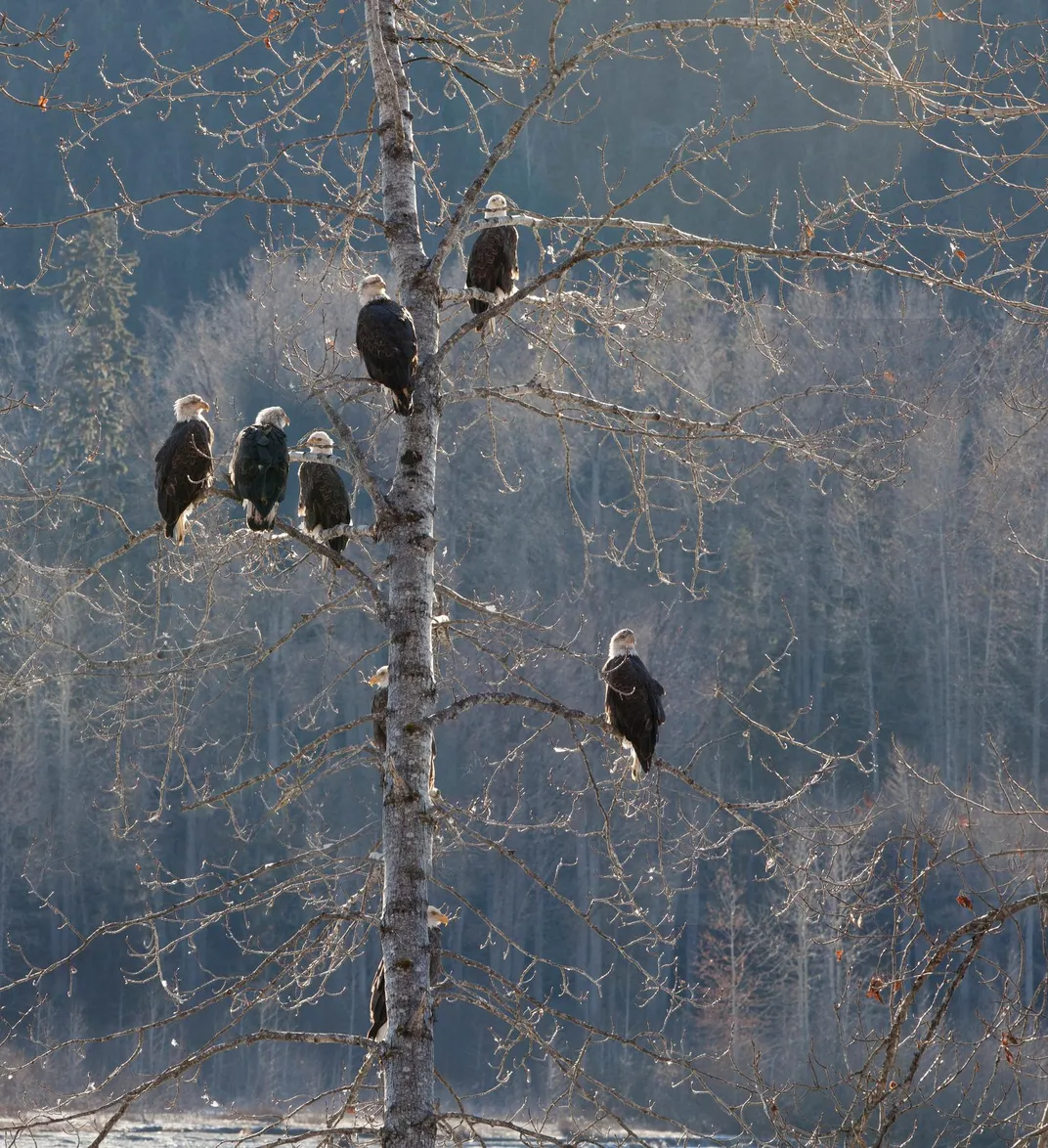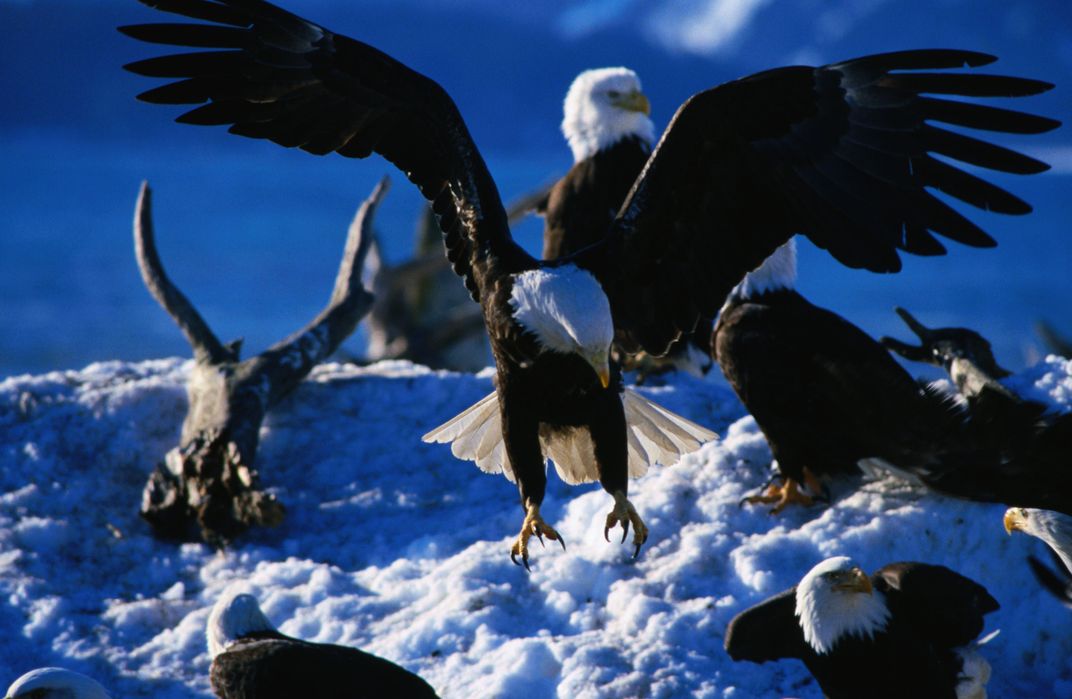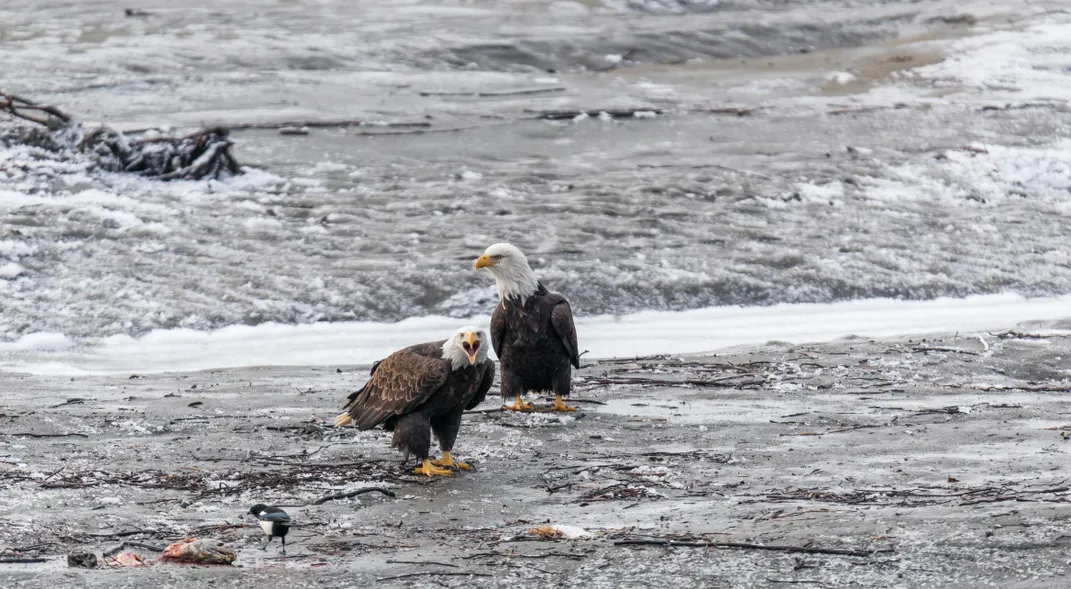Behold the Largest Congregation of Bald Eagles in the United States
Every November, hundreds if not thousands of the birds of prey gather in Haines, Alaska, to feast on salmon
/https://tf-cmsv2-smithsonianmag-media.s3.amazonaws.com/filer/b6/fa/b6fa47f1-318d-411d-97f6-55bcdecb340d/bald_eagle-main.jpg)
Despite pandemic-caused shutdowns and travel restrictions across Alaska, a small valley in the Southeast still expects its habitual visitors: bald eagles. In early November, thousands of the birds of prey gather in Haines, Alaska, forming one of the largest congregations of the species in the world.
Alaskans often depict their location in the state by using their right hand as a map. With just a pointer finger and thumb extended, thumb pointing down, the Chilkat Valley—also known as the Valley of the Eagles—is where thumb meets hand on Alaska’s panhandle.
The Chilkat Valley, a peninsula saddled between glaciated mountain chains and the Chilkat and Chilkoot river systems, is nearly 75 miles north of Juneau. The valley extends from the Canadian border south, past the indigenous village of Klukwan, to the small town of Haines, originally called Deishú by Alaska Natives, or “end of the trail.” Sitting on the deepest fjord in North America, Haines (population: 2,500) can be reached by small plane or ferry from Juneau or by car from Canada. The town draws tourists seeking world-renowned heli-skiing, hiking, local brews, a thriving arts scene and, of course, bald eagle sightings.

The area is home to about 500 residential eagles that attract visitors year-round, most especially in the fall when migrating birds up the count to historic highs of 3,000. Eagles flock to the Chilkat River flats along the Haines Highway in early November for its unique hydrology. Percolating groundwater keeps late fall runs of chum and coho salmon spawning well into winter months, providing food for the birds.
“The eagles still have access to the chum (salmon) well into November and December because there is upwelling in this area that prevents the river from freezing,” says Nicole Zeiser, the Haines’ area management biologist for the Alaska Department of Fish and Game.
In 1982, the State of Alaska established the Alaska Chilkat Bald Eagle Preserve, setting aside 48,000 acres of river-bottom to protect the eagle habitat and all five species of pacific salmon found there. That same year, a Haines local formed The American Bald Eagle Foundation (ABEF) to educate visitors on the region’s unique asset. The foundation serves as both a museum and live raptor center, home to several rehabilitated bird species called “avian ambassadors.” For the last 25 years, the nonprofit has hosted an annual four-day festival around the congregation of the eagles, consisting of a speaker series on local ecology, an artist bazaar and a film screening. For the grand finale, visitors are driven up the highway to witness a rehabilitated eagle release, followed by a banquet dinner.
Due to Covid-19 risks and stringent state travel restrictions, the festival, which typically draws around 300 visiting birders, photographers and tourists from all over the world, has been canceled. But the bald eagles, of course, haven’t gotten the message—and local residents never tire of the natural phenomenon.
One of those locals is Pam Randles, a now-retired high school science teacher and naturalist guide in Haines. Randles began counting the fall eagle migration 20 years ago as part of her teaching curriculum, and can’t quit.
“I watched them for so many years, I just have to go out to look,” she admits. On an overcast afternoon in mid-October, Randles drives her rig roughly 12 miles out to the Chilkoot River on the other of the peninsula, one of three rivers spawning salmon swim up before ending in the Chilkat River. Her binoculars bounce over potholes on the passenger seat.
“The eagles were everywhere, sitting in the trees waiting for the tides to go down so they could get some fish,” Randles recounts later that day. She laughs, describing an opportunist eagle who once snatched a fisherman’s pole with pink on the line. “It’s so cool to see them.”

The best viewing area for the eagles is the pullout off the Haines Highway at Mile Post 21 (marked by signs). The peak of congregation typically coincides, not incidentally, with the festival in the second week of November. Photographers line the river bed with tripods and all-weather gear to capture eagles in flight. When they spot salmon, the birds launch from their perch in the trees beside the river and land on their prey, dragging it to the adjacent shore to feed. Often, spectators catch a confluence of ravens and magpies that swoop in to squabble for the same fish. Late-denning grizzly bears sometimes join in on the fish feast.
The average high count of eagles is about 1,000 birds a year, counted from the ground, Randles says. That number is higher when aerial surveying is used, but plane data over the last 20 years is less consistent. The all-time high was in 2000, when Randles documented just shy of 3,000 birds. From 2009 to 2015, Randles’ counts averaged between 700 and 900 eagles.
The number of eagles in an area correlates with the abundance of fish, Randles says. In recent years, poor salmon returns in some stocks, or groups of salmon specific to certain areas, have meant a decline in eagles. This year, the Chilkat stock of chum failed to meet the healthy population estimate, or “escapement goal,” set by state biologists. State biologists measure the health of chum by counting those that come through a fish wheel on the Chilkat River, eight miles outside of Haines along the highway, then extrapolating from that number a goal population size.
Chum salmon missed their escapement goal range for 2020 significantly, by more than 50,000 fish, Zeiser says. She added that chum numbers across the state were a bust this year. State and federal agencies aren’t sure why this happened, though evidence points to environmental factors, such as poor ocean survival from fluctuating ocean temperatures or a lack of prey.
With less chum around, Zeiser says the eagles will have a harder time catching fish. Still, she’s confident the birds will survive one way or another. Missing the escapement goal one year is not a huge concern; falling short of it year after year is when it becomes an issue, according to the biologist. In 2017, the Board of Fisheries labeled the Chilkat king salmon a “stock of concern” after five years of diminishing returns. Since, more rigorous management has been put in place, contributing to a slight rebound in the stock.
“There are some coho salmon that also hang out and spawn in this area,” Zeiser says. “There should be something around for the eagles to eat, and if not, I’m sure they would adapt and eat a different food source to survive.”

When Tony Strong sips his coffee each morning from his home facing downriver on the Chilkat in Klukwan, he sees a host of animals who, like him, are indigenous to the land. Strong is Alaska Native Tlingit, a member of the Eagle-Wolf clan.
“When I see a large group of eagles, I’m seeing— emotionally—part of my family,” Strong says.
In the ancient village of Klukwan, salmon has provided sustenance as a primary source of protein for indigenous people for thousands of years. “This year has been worse than others,” Strong says of the fishing season. “Last year, you’d catch up to 100 [salmon] in one day.”
Typically, the Alaska Bald Eagle Festival’s eagle release takes place within the village, while a local group performs traditional Tlingit dances on the bank of the Chilkat River. Admission to the festival not only helps fund the foundation, but the influx of visitors helps support Klukwan’s museum, the Jilkaat Kwaan Heritage Center, which in turn helps preserve traditional knowledge and important clan regalia.
Klukwan sealed itself off from outside entry in March to protect village elders from Covid-19 infection. While the American Bald Eagle Foundation will remain open to visitors who follow state protocols and arrive in Haines, director Cheryl McRoberts urges would-be festivalgoers to hang on until next year.
Until then, locals in the Chilkat Valley are enjoying the eagles all to themselves.
“They’re starting to accumulate on the trees next to my house,” says Strong, who goes on to talk about the natural world around him. “We share this home with the eagles and with the ravens. They’re our neighbors. I am happy that people recognize our home as the home of the eagles, as well.”
/https://tf-cmsv2-smithsonianmag-media.s3.amazonaws.com/accounts/headshot/JennaKunze.png)
/https://tf-cmsv2-smithsonianmag-media.s3.amazonaws.com/accounts/headshot/JennaKunze.png)